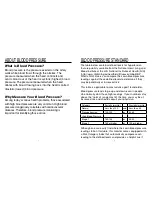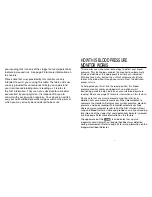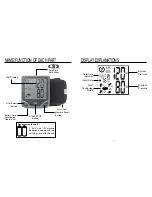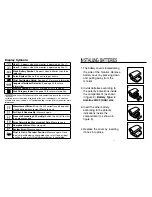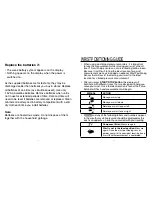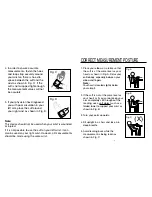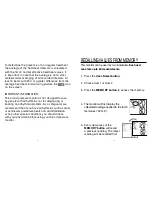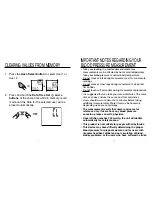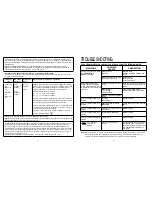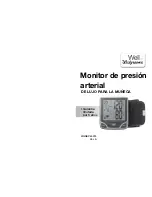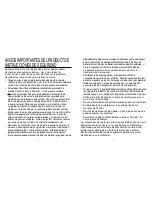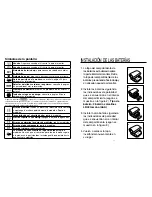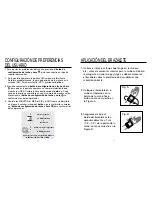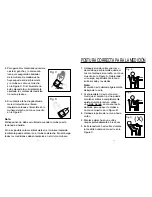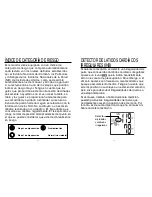
33
34
Note: If the unit still does not work, contact HoMedics Consumer Relations. Under no circumstance
should you disassemble or attempt to repair the unit by yourself. Contact information for
HoMedics Consumer Relations Department can be found on the warranty page.
SYMPTOMS
POSSIBLE
CAUSES
CORRECTION
Unit does not turn on when
the
START/STOP
button is pushed.
Batteries have
run down.
Replace them
with two new AAA alkaline bat-
teries.
Battery polarities have been
positioned incorrectly.
Re-insert the
batteries in the
correct positions.
EE measurement error
symbol shown on display
or the blood pressure value
is displayed excessively low
(or high).
Cuff has been placed incor-
rectly.
Wrap the cuff properly so that it
is positioned correctly. Measure
again.
Did you talk or
move during
measurement?
Keep wrist steady during
measurement. Measure again.
Shaking of the wrist with the
cuff on.
E1 error symbol shown on
display
Air circuit
abnormality.
Measure again.
E2 error symbol shown on
display
Inflation pressure exceeding
300 mmHg.
Switch the unit off, then measure
again.
E3 error symbol shown on
display
Error determining measure-
ment data.
Measure again.
E4 error symbol shown on
display
Component malfunction.
Measure again.
EP error symbol shown on
display
System error.
Measure again.
error symbol
appears on
display
Wrist is not in the ideal
position.
Measure again. Once the wrist
positioning sensor guides your
wrist to your ideal location, keep
arm still until measurement is
complete.
TROUBLESHOOTING
If any abnormality arises during use, please check the following points:
PM
AVG.
3
UP
DOWN
ROTATE
RIGHT
LEFT
For transmitters rated at a maximum output power not listed above, the recommended separation dis-
tance d in metres (m) can be estimated using the equation applicable to the frequency of the transmitter,
where P is the maximum output power rating of the transmitter in watts (W) according to the transmitter
manufacturer.
NOTE 1 At 80 MHz and 800 MHz, the separation distance for the higher frequency range applies.
NOTE 2 These guidelines may not apply in all situations. Electromagnetic propagation is affected by
absorption and reflection from structures, objects and people.
• Guidance and manufacturer’s declaration – electromagnetic immunity
The device is intended for use in the electromagnetic environments listed below, and should only be
used in such environments:
Immunity
test
IEC 60601
test level
Compliance
level
Electromagnetic environment – guidance
Conducted
RF
IEC 61000-
4-6
Radiated
RF
IEC 61000-
4-3
3 Vrms
150 kHz to
80 MHz
3 V/m
80 MHz to
2.5 GHz
Not Ap-
plicable
3 V/m
Portable and mobile RF communications equipment should be
used no closer to any part of the device, including cables, than
the recommended separation distance calculated from the
equation applicable to the frequency of the transmitter.
Recommended separation distance
d = 1.2
80 MHz to 800 MHz
d = 2 .3
800 MHz to 2.5 GHz
where P is the maximum output power rating of the transmitter
in watts (W) according to the transmitter manufacturer and d is
the recommended separation distance in metres (m).
Field strengths from fixed RF transmitters, as determined by an
electromagnetic site survey, a should be less than the compli-
ance level in each frequency range.b
Interference may occur in the vicinity of equipment marked
with the following symbol:
NOTE 1 At 80 MHz and 800 MHz, the higher frequency range applies.
NOTE 2 These guidelines may not apply in all situations. Electromagnetic propagation is affected by absorp-
tion and reflection from structures, objects and people.
a Field strengths from fixed transmitters, such as base stations for radio (cellular/cordless) telephones and
land mobile radios, amateur radio, AM and FM radio broadcast and TV broadcast cannot be predicted
theoretically with accuracy. To assess the electromagnetic environment due to fixed RF transmitters, an
electromagnetic site survey should be considered. If the measured field strength in the location in which the
device is used exceeds the applicable RF compliance level above, the device should be observed to verify
normal operation. If abnormal performance is observed, additional measures may be necessary, such as
reorienting or relocating the device.
b Over the frequency range 150 kHz to 80 MHz, field strengths should be less than 3 V/m.
Summary of Contents for Deluxe Wrist WGNBPW-720
Page 41: ...IB WGNBPW720A ...

